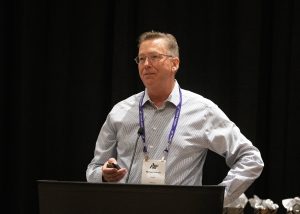
“As income goes up, there is more meat consumption per capita. As populations get wealthier, they are going to want to eat more like we do,” said Dr. Mike Lohuis, The Semex Alliance vice president of research and innovation. Lohuis gave his presentation titled “Changing the Narrative Using Innovative Genetic Selection” during the 2023 Beef Improvement Federation (BIF) Symposium July 4, in Calgary, Alberta, Canada.
Lohuis described the current narrative of livestock as being a high-quality source of protein, an enjoyable food source, a large contributor to economies and essential for developing countries. However, there is another narrative. This narrative focuses on the consumer concerns of environmental impacts, animal welfare, antibiotic use, factory farms, depletion of resources and deforestation.
Environmental concerns
The livestock sector globally is responsible for 18 percent of greenhouse gas emissions measured in a CO2 equivalent – which some studies have shown is comparable to emissions from transportation. Thus, the environmental impact per unit of livestock production must be cut by half. This will avoid the increasing level of damage beyond the current level. Stock gases like CO2 will continue to accumulate over time but flow gases like methane could stay constant or decrease over time.
“What’s more important than the amount of methane is the rate of change,” Lohuis explained. “If animal agriculture can decrease the amount of methane emissions, there’s the potential to reduce its warming potential in our atmosphere.”
Animal health and welfare
The health and welfare of beef animals can be difficult to measure in various production systems due to the difficulties in obtaining reliable health and management data, and the variation in management of animals contributes to low heritability. However, sensor data can be used to measure health and welfare as the data is abundant, affordable and longitudinal. Immunity and health data has shown that immune response is more heritable than disease incidence. Thus, high immunity cows respond better to commercial vaccines. Beef producers will soon be able to breed for health and welfare traits due to the increase in innovative genetic technologies.
Beef x Dairy
The use of beef semen is now a standard practice for about 90 percent of dairy herds, which is turning a byproduct into a core product. Changing the narrative begins with changing the mindset of dairy producers to produce beef calves with the same selection pressure that they place on their replacement dairy females. Sire selection for beef x dairy production systems is critical to address the deficiencies of dairy genetics including slower growth rates, lower feed conversion, ribeye shape, meat color and liver abscesses.
“Beef x dairy animals can lower the environmental footprint of our beef supply,” Lohuis said. “The beef x dairy animal starts its life with about 40 percent less emissions compared to its beef or dairy counterparts.”
A challenging narrative has formed around animal agriculture. However, beef producers possess the skills and tools to meet the expectations of the beef industry and society. The beef industry needs to tell the story of how innovative genetic selection can mitigate climate change, improve animal health and welfare, improve the environment and provide more sustainable beef.
To watch Lohuis’ full presentation, visit https://youtu.be/iiarA6p_S5U. For more information about this year’s symposium and the Beef Improvement Federation, including additional presentations and award winners, visit BIFSymposium.com.
